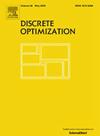Computational aspects of lifted cover inequalities for knapsacks with few different weights
IF 1.6
4区 数学
Q3 MATHEMATICS, APPLIED
引用次数: 0
Abstract
Cutting planes are frequently used for solving integer programs. A common strategy is to derive cutting planes from building blocks or a substructure of the integer program. In this paper, we focus on knapsack constraints that arise from single row relaxations. Among the most popular classes derived from knapsack constraints are lifted minimal cover inequalities. The separation problem for these inequalities is NP-hard though, and one usually separates them heuristically, therefore not fully exploiting their potential.
For many benchmarking instances however, it turns out that many knapsack constraints only have few different coefficients. This motivates the concept of sparse knapsacks where the number of different coefficients is a small constant, independent of the number of variables present. For such knapsacks, we observe that there are only polynomially many different classes of structurally equivalent minimal covers. This opens the door to specialized techniques for using lifted minimal cover inequalities.
In this article we will discuss two such techniques, which are based on specialized sorting methods. On the one hand, we present new separation routines that separate equivalence classes of inequalities rather than individual inequalities. On the other hand, we derive compact extended formulations that express all lifted minimal cover inequalities by means of a polynomial number of constraints. These extended formulations are based on tailored sorting networks that express our separation algorithm by linear inequalities. We conclude the article by a numerical investigation of the different techniques for popular benchmarking instances.
具有少量不同重量的背包的提升覆盖不等式的计算方面
切平面常用于求解整数程序。一种常见的策略是从构建块或整数程序的子结构中导出切割平面。在本文中,我们关注由单行松弛引起的背包约束。从背包约束中得到的最受欢迎的类是解除最小覆盖不等式。然而,这些不等式的分离问题是np困难的,人们通常会启发式地分离它们,因此不能充分利用它们的潜力。然而,对于许多基准测试实例,事实证明许多背包约束只有很少的不同系数。这激发了稀疏背包的概念,其中不同系数的数量是一个小常数,与存在的变量数量无关。对于这样的背包,我们观察到只有多项式多个不同类别的结构等效最小覆盖。这为使用提升的最小覆盖不等式的专门技术打开了大门。在本文中,我们将讨论两种这样的技术,它们基于专门的排序方法。一方面,我们提出了新的分离例程来分离不等式的等价类而不是单个不等式。另一方面,我们利用多项式个数的约束,导出了表示所有提升极小覆盖不等式的紧扩展公式。这些扩展的公式是基于定制的排序网络,通过线性不等式来表达我们的分离算法。我们通过对常用基准测试实例的不同技术进行数值研究来结束本文。
本文章由计算机程序翻译,如有差异,请以英文原文为准。
求助全文
约1分钟内获得全文
求助全文
来源期刊

Discrete Optimization
管理科学-应用数学
CiteScore
2.10
自引率
9.10%
发文量
30
审稿时长
>12 weeks
期刊介绍:
Discrete Optimization publishes research papers on the mathematical, computational and applied aspects of all areas of integer programming and combinatorial optimization. In addition to reports on mathematical results pertinent to discrete optimization, the journal welcomes submissions on algorithmic developments, computational experiments, and novel applications (in particular, large-scale and real-time applications). The journal also publishes clearly labelled surveys, reviews, short notes, and open problems. Manuscripts submitted for possible publication to Discrete Optimization should report on original research, should not have been previously published, and should not be under consideration for publication by any other journal.
 求助内容:
求助内容: 应助结果提醒方式:
应助结果提醒方式:


